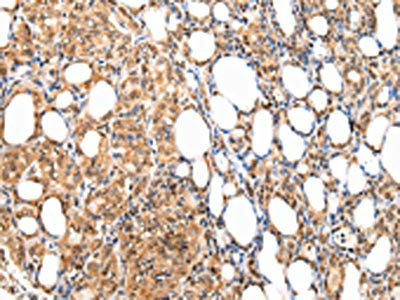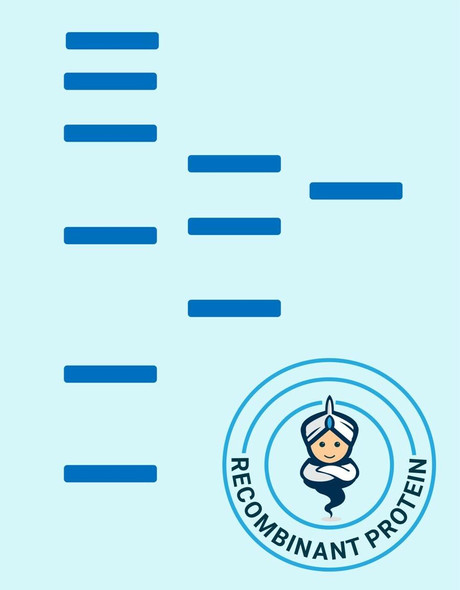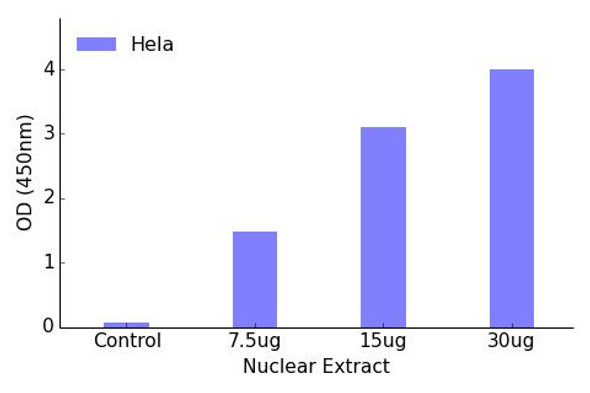Description
| Antibody Name: | ATF1 Antibody (PACO20989) |
| Antibody SKU: | PACO20989 |
| Size: | 50ul |
| Host Species: | Rabbit |
| Tested Applications: | ELISA, IHC |
| Recommended Dilutions: | ELISA:1:2000-1:5000, IHC:1:25-1:100 |
| Species Reactivity: | Human, Mouse |
| Immunogen: | Synthetic peptide of human ATF1 |
| Form: | Liquid |
| Storage Buffer: | -20°C, pH7.4 PBS, 0.05% NaN3, 40% Glycerol |
| Purification Method: | Antigen affinity purification |
| Clonality: | Polyclonal |
| Isotype: | IgG |
| Conjugate: | Non-conjugated |
 | The image on the left is immunohistochemistry of paraffin-embedded Human thyroid cancer tissue using PACO20989(ATF1 Antibody) at dilution 1/35, on the right is treated with synthetic peptide. (Original magnification: x200). |
 | The image on the left is immunohistochemistry of paraffin-embedded Human lung cancer tissue using PACO20989(ATF1 Antibody) at dilution 1/35, on the right is treated with synthetic peptide. (Original magnification: x200). |
| Background: | This gene encodes an activating transcription factor, which belongs to the ATF subfamily and bZIP (basic-region leucine zipper) family. It influences cellular physiologic processes by regulating the expression of downstream target genes, which are related to growth, survival, and other cellular activities. This protein is phosphorylated at serine 63 in its kinase-inducible domain by serine/threonine kinases, cAMP-dependent protein kinase A, calmodulin-dependent protein kinase I/II, mitogen- and stress-activated protein kinase and cyclin-dependent kinase 3 (cdk-3). Its phosphorylation enhances its transactivation and transcriptional activities, and enhances cell transformation. Fusion of this gene and FUS on chromosome 16 or EWSR1 on chromosome 22 induced by translocation generates chimeric proteins in angiomatoid fibrous histiocytoma and clear cell sarcoma. This gene has a pseudogene on chromosome 6. |
| Synonyms: | activating transcription factor 1 |
| UniProt Protein Function: | ATF-1: a transcription factor that is a member of the leucine zipper family. Forms a homodimer or heterodimer with c-Jun and stimulates CRE-dependent transcription. Binds the Tax-responsive element (TRE) of HTLV-I. Activated downstream of IL-1. c-Src and TRAF6 are mediators of IL-1-induced AP-1 activation. Plays an important role in the trans-activation of the MHC class II trans-activator (CIITA) promoter III in B cells. |
| UniProt Protein Details: | Protein type:Transcription factor Chromosomal Location of Human Ortholog: 12q13 Cellular Component: nucleoplasm; nucleus Molecular Function:protein binding; protein complex binding; protein heterodimerization activity; RNA polymerase II transcription factor activity, enhancer binding; transcription factor activity Biological Process: cellular protein complex assembly; innate immune response; MyD88-dependent toll-like receptor signaling pathway; MyD88-independent toll-like receptor signaling pathway; nerve growth factor receptor signaling pathway; positive regulation of DNA replication; positive regulation of transcription from RNA polymerase II promoter; response to cobalt ion; response to organic cyclic substance; stress-activated MAPK cascade; toll-like receptor 10 signaling pathway; toll-like receptor 2 signaling pathway; toll-like receptor 3 signaling pathway; toll-like receptor 4 signaling pathway; toll-like receptor 5 signaling pathway; toll-like receptor 9 signaling pathway; toll-like receptor signaling pathway; transcription from RNA polymerase II promoter |
| NCBI Summary: | This gene encodes an activating transcription factor, which belongs to the ATF subfamily and bZIP (basic-region leucine zipper) family. It influences cellular physiologic processes by regulating the expression of downstream target genes, which are related to growth, survival, and other cellular activities. This protein is phosphorylated at serine 63 in its kinase-inducible domain by serine/threonine kinases, cAMP-dependent protein kinase A, calmodulin-dependent protein kinase I/II, mitogen- and stress-activated protein kinase and cyclin-dependent kinase 3 (cdk-3). Its phosphorylation enhances its transactivation and transcriptional activities, and enhances cell transformation. Fusion of this gene and FUS on chromosome 16 or EWSR1 on chromosome 22 induced by translocation generates chimeric proteins in angiomatoid fibrous histiocytoma and clear cell sarcoma. This gene has a pseudogene on chromosome 6. [provided by RefSeq, Aug 2010] |
| UniProt Code: | P18846 |
| NCBI GenInfo Identifier: | 1168542 |
| NCBI Gene ID: | 466 |
| NCBI Accession: | P18846.2 |
| UniProt Secondary Accession: | P18846,P25168, Q9H4A8, B4DRF9, |
| UniProt Related Accession: | P18846,AAB25878 |
| Molecular Weight: | 15,295 Da |
| NCBI Full Name: | Cyclic AMP-dependent transcription factor ATF-1 |
| NCBI Synonym Full Names: | activating transcription factor 1 |
| NCBI Official Symbol: | ATF1 |
| NCBI Official Synonym Symbols: | TREB36; EWS-ATF1; FUS/ATF-1 |
| NCBI Protein Information: | cyclic AMP-dependent transcription factor ATF-1 |
| UniProt Protein Name: | Cyclic AMP-dependent transcription factor ATF-1 |
| UniProt Synonym Protein Names: | Activating transcription factor 1; Protein TREB36 |
| Protein Family: | Alcohol O-acetyltransferase |
| UniProt Gene Name: | ATF1 |
| UniProt Entry Name: | ATF1_HUMAN |
| Secondary Antibody |
| Anti-HRP Goat Anti-Rabbit IgG (H+L) Antibody (CABS014) |
| Recommended Products |
| Anti-FITC Goat Anti-Rabbit IgG (H+L) Antibody (CABS011) |
| Anti-HRP-conjugated Beta Actin Antibody (CABC028) |






